Quantifying the Impacts of Urbanization on Urban Agriculture and Food Security in the Megacity Lahore, Pakistan
Abstract
1. Introduction
2. Review of Literature
3. Methodology
3.1. Study Area
3.2. Selection of Study Area and Data Collection
3.3. Data Analysis
4. Results
Impacts of Urbanization on Agricultural Land
5. Discussion
6. Conclusions
Author Contributions
Funding
Data Availability Statement
Acknowledgments
Conflicts of Interest
References
- Kaiser, N.; Douches, D.; Dhingra, A.; Glenn, K.C.; Herzig, P.R.; Stowe, E.C.; Swarup, S. The role of conventional plant breeding in ensuring safe levels of naturally occurring toxins in food crops. Trends Food Sci. Technol. 2020, 100, 51–66. [Google Scholar] [CrossRef]
- Addo, K.A. Urban and Peri-Urban Agriculture in Developing Countries Studied using Remote Sensing and In Situ Methods. Remote Sens. 2010, 2, 497–513. [Google Scholar] [CrossRef]
- Zulfiqar, F.; Shang, J.; Yasmeen, S.; Wattoo, M.U.; Nasrullah, M.; Alam, Q. Urban agriculture can transform the sustainable food security for urban dwellers in Pakistan. GeoJournal 2020, 86, 2419–2433. [Google Scholar] [CrossRef]
- Aziz, A.; Anwar, M.M.; Dawood, M. The impact of neighborhood services on land values: An estimation through the hedonic pricing model. GeoJournal 2021, 86, 1915–1925. [Google Scholar] [CrossRef]
- Cui, L.; Shi, J. Urbanization and its environmental effects in Shanghai, China. Urban Clim. 2012, 2, 1–15. [Google Scholar] [CrossRef]
- Rahut, D.B.; Aryal, J.P.; Manchanda, N.; Sonobe, T. Chapter 6—Expectations for household food security in the coming decades: A global scenario. In Future Foods; Bhat, R., Ed.; Academic Press: Cambridge, MA, USA, 2022; pp. 107–131. [Google Scholar] [CrossRef]
- Grote, U.; Fasse, A.; Nguyen, T.T.; Erenstein, O. Food Security and the Dynamics of Wheat and Maize Value Chains in Africa and Asia. Front. Sustain. Food Syst. 2021, 4, 617009. [Google Scholar] [CrossRef]
- Haq, S.U.; Boz, I.; Shahbaz, P. Adoption of climate-smart agriculture practices and differentiated nutritional outcome among rural households: A case of Punjab province, Pakistan. Food Secur. 2021, 13, 913–931. [Google Scholar] [CrossRef]
- Farhangi, M.; Farhangi, S.; van de Vlasakker, P.C.H.; Carsjens, G.J. The Role of Urban Agriculture Technologies in Transformation toward Participatory Local Urban Planning in Rafsanjan. Land 2021, 10, 830. [Google Scholar] [CrossRef]
- Muluneh, M.G. Impact of climate change on biodiversity and food security: A global perspective—A review article. Agric. Food Secur. 2021, 10, 36. [Google Scholar] [CrossRef]
- Food and Agriculture Organization of the United Nations. Urban and Peri-Urban Agriculture. 2023. Available online: https://www.fao.org/urban-peri-urban-agriculture/en (accessed on 27 April 2023).
- Miguel, A.; Nelso, C.; Kristina, C.; Catherine, M.; Peter, R.; Martin, B.; Clara, N. The greening of the “barrios”: Urban agriculture for food security in Cuba. Agric. Hum. Values 1998, 16, 131–140. [Google Scholar]
- De Bruin, S.; Dengerink, J.; Van Vliet, J. Urbanisation as driver of food system transformation and opportunities for rural livelihoods. Food Secur. 2021, 13, 781–798. [Google Scholar] [CrossRef]
- Wang, C.; Gao, Y.; Aziz, A.; Ogunmola, G.A. Agricultural Disaster Risk Management and Capability Assessment Using Big Data Analytics. Big Data 2022, 10, 246–261. [Google Scholar] [CrossRef]
- Aziz, A.; Anwar, M.M.; Rani, M.; Ahmad, S.; Zaheer, S. Indication of Urban expansion of Gujranwala city (Pakistan) by Remote sensing and GIS. Environ. Earth Ecol. 2019, 3, 13–23. [Google Scholar] [CrossRef]
- Eddington, G.; Kashangura, M.T. Broiler production in an urban and peri-urban area of Zimbabwe. Dev. S. Afr. 2016, 33, 99–112. [Google Scholar] [CrossRef]
- Pribadi, D.O.; Pauleit, S. The dynamics of peri-urban agriculture during rapid urbanization of Jabodetabek Metropolitan Area. Land Use Policy 2015, 48, 13–24. [Google Scholar] [CrossRef]
- Abdullah; Zhou, D.; Shah, T.; Ali, S.; Ahmad, W.; Ud Din, I.; Ilysa, A. Factors affecting household food security in rural northern hinterland of Pakistan. J. Saudi Soc. Agric. Sci. 2019, 18, 201–210. [Google Scholar] [CrossRef]
- Schleifer, P.; Sun, Y. Reviewing the impact of sustainability certification on food security in developing countries. Glob. Food Secur. 2020, 24, 100337. [Google Scholar] [CrossRef]
- Sanyé-Mengual, E.; Gasperi, D.; Michelon, N.; Orsini, F.; Ponchia, G.; Gianquinto, G. Eco-Efficiency Assessment and Food Security Potential of Home Gardening: A Case Study in Padua, Italy. Sustainability 2018, 10, 2124. [Google Scholar] [CrossRef]
- Chagomoka, T.; Drescher, A.; Glaser, R.; Marschner, B.; Schlesinger, J.; Nyandoro, G. Contribution of urban and periurban agriculture to household food and nutrition security along the urban–rural continuum in Ouagadougou, Burkina Faso. Renew. Agric. Food Syst. 2015, 32, 5–20. [Google Scholar] [CrossRef]
- U.S. Department of Agriculture. Urban Agriculture. Farms and Agricultural Production Systems. 2023. Available online: https://www.nal.usda.gov/farms-and-agricultural-production-systems/urban-agriculture (accessed on 27 April 2023).
- Adjei, P.O.-W.; Kosoe, E.A.; Forkuor, D. Facts behind the myth of conservative rurality: Major determinants of rural farmers’ innovation adoption decisions for sustainable agriculture. GeoJournal 2017, 82, 1051–1066. [Google Scholar] [CrossRef]
- Armar-Klemesu, M. Urban Agriculture and Food Security, Nutrition and Health; Sage: Newcastle upon Tyne, UK, 1998. [Google Scholar]
- Gao, S.; Xu, Z.; Jin, T.; Wei, L.; Ju, X.; Xi, B.; Xue, Y. Analysis of eco-agriculture construction based on rural revitalization in China. Chin. J. Eco-Agric. 2019, 27, 163–168. [Google Scholar] [CrossRef]
- Mwinuka, L.; Mutabazi, K.; Graef, F.; Maeda, C.; Makoko, B.; Swai, E. Agri-Food Value Chain Upgrading Strategies Choices: A Participatory Smallholder Farmer Centred Approach. In Proceedings of the Plant2030 Status Seminar, Berlin, Germany, 4–6 March 2015. [Google Scholar]
- Faehnle, M.; Söderman, T.; Schulman, H.; Lehvävirta, S. Scale-sensitive integration of ecosystem services in urban planning. GeoJournal 2015, 80, 411–425. [Google Scholar] [CrossRef]
- Cattivelli, V. Planning peri-urban areas at regional level: The experience of Lombardy and Emilia-Romagna (Italy). Land Use Policy 2021, 103, 105282. [Google Scholar] [CrossRef]
- Dutta, I.; Das, A. Exploring the dynamics of spatial inequality through the development of sub-city typologies in English Bazar Urban Agglomeration and its peri urban areas. GeoJournal 2019, 84, 829–849. [Google Scholar] [CrossRef]
- Orsini, F.; Kahane, R.; Nono-Womdim, R.; Gianquinto, G. Urban agriculture in the developing world: A review. Agron. Sustain. Dev. 2013, 33, 695–720. [Google Scholar] [CrossRef]
- Atif, R.M.; Liu, H.; Mahmood, H. Pakistan’s agricultural exports, determinants and its potential: An application of stochastic frontier gravity model. J. Int. Trade Econ. Dev. 2017, 26, 257–276. [Google Scholar] [CrossRef]
- Rezai, G.; Shamsudin, M.N.; Mohamed, Z. Urban Agriculture: A Way Forward to Food and Nutrition Security in Malaysia. Procedia-Soc. Behav. Sci. 2016, 216, 39–45. [Google Scholar] [CrossRef]
- Singh, S.; Singh, D.R.; Velmurugan, A.; Jaisankar, I.; Swarnam, T.P. Chapter 23—Coping with Climatic Uncertainties Through Improved Production Technologies in Tropical Island Conditions. In Biodiversity and Climate Change Adaptation in Tropical Islands; Sivaperuman, C., Velmurugan, A., Singh, A.K., Jaisankar, I., Eds.; Academic Press: Cambridge, MA, USA, 2008; pp. 623–666. [Google Scholar] [CrossRef]
- Muhammad, H.; Tahir, S. British Architecture of Lahore: An Introductory Note of their Religious and Educational Buildings. J. Punjab Univ. Hist. Soc. 2018, 31, 13. [Google Scholar]
- Government of Pakistan. 6th Census of Pakistan. In Pakistan Census; Pakistan Bureau of Statistics: Islamabad, Pakistan, 2017; Volume 2018. [Google Scholar]
- Basharat, M. Chapter 8—Groundwater Environment in Lahore, Pakistan. In Groundwater Environment in Asian Cities; Shrestha, S., Pandey, V.P., Shivakoti, B.R., Thatikonda, S., Eds.; Butterworth-Heinemann: Oxford, UK, 2016; pp. 147–184. [Google Scholar] [CrossRef]
- Shirazi, S.A.; Kazmi, J. Analysis of Population Growth and Urban Development in Lahore- Pakistan using Geospatial Techniques: Suggesting some Future Options. J. S. Asian Stud. 2014, 29, 293–305. [Google Scholar]
- Anwar, M.M.; Fayyaz, F.; Aziz, A.; Mahmood, M.R. Socio-Ecological and Ethical Economic Demand of Urban Parks in Gujrat City, Punjab, Pakistan. Arid Ecosyst. 2021, 11, 141–148. [Google Scholar] [CrossRef]
- Anwar, M.M.; Hashim, M.; Aziz, A.; Stocco, A.; Abdo, H.G.; Almohamad, H.; Al Dughairi, A.A.; Al-Mutiry, M. Urban Green Spaces Distribution and Disparities in Congested Populated Areas: A Geographical Assessment from Pakistan. Sustainability 2023, 15, 8059. [Google Scholar] [CrossRef]
- Aziz, A.; Anwar, M.M.; Abdo, H.G.; Almohamad, H.; Al Dughairi, A.A.; Al-Mutiry, M. Proximity to Neighborhood Services and Property Values in Urban Area: An Evaluation through the Hedonic Pricing Model. Land 2023, 12, 859. [Google Scholar] [CrossRef]
- Jansma, J.E.; Wertheim-Heck, S.C.O. Feeding the city: A social practice perspective on planning for agriculture in peri-urban Oosterwold, Almere, the Netherlands. Land Use Policy 2022, 117, 106104. [Google Scholar] [CrossRef]
- Deelstra, T.; Girardet, H. Urban agriculture and sustainable cities. In Growing Cities, Growing Food: Urban Agriculture on the Policy Agenda; Deutsche Stiftung fur internationale Entwicklung (DSE): Feldafing, Germany, 2000; pp. 43–65. [Google Scholar]
- Gottero, E.; Cassatella, C.; Larcher, F. Planning Peri-Urban Open Spaces: Methods and Tools for Interpretation and Classification. Land 2021, 10, 802. [Google Scholar] [CrossRef]
- Lee-Smith, D.; Prain, G.; Cofie, O.; van Veenhuizen, R.; Karanja, N. Urban and Peri-Urban Farming Systems. In Farming Systems and Food Security in Africa; Routledge: Oxford, UK, 2019; pp. 504–531. [Google Scholar] [CrossRef]
- Lwasa, S.; Mugagga, F.; Wahab, B.; Simon, D.; Connors, J.; Griffith, C. Urban and peri-urban agriculture and forestry: Transcending poverty alleviation to climate change mitigation and adaptation. Urban Clim. 2014, 7, 92–106. [Google Scholar] [CrossRef]
- Samiullah, M.A.K.; Rahman, A.-U.; Mahmood, S. Evaluation of urban encroachment on farmland. A threat to urban agriculture in peshawar city district, Pakistan. Erdkunde 2019, 73, 127–142. [Google Scholar] [CrossRef]
- Ahmad, M.; Farooq, U. The State of Food Security in Pakistan: Future Challenges and Coping Strategies. Pak. Dev. Rev. 2010, 49, 903–923. [Google Scholar] [CrossRef]
- Langemeyer, J.; Madrid-Lopez, C.; Beltran, A.M.; Mendez, G.V. Urban agriculture—A necessary pathway towards urban resilience and global sustainability? Landsc. Urban Plan. 2021, 210, 104055. [Google Scholar] [CrossRef]
- Cimino, O.; Vassallo, M.; Henke, R.; Vanni, F. Income Diversification Strategies of Italian Peri-Urban Farms: A Structural Equation Modeling Approach. Land 2021, 10, 790. [Google Scholar] [CrossRef]
- Tapia, C.; Randall, L.; Wang, S.; Aguiar Borges, L. Monitoring the contribution of urban agriculture to urban sustainability: An indicator-based framework. Sustain. Cities Soc. 2021, 74, 103130. [Google Scholar] [CrossRef]
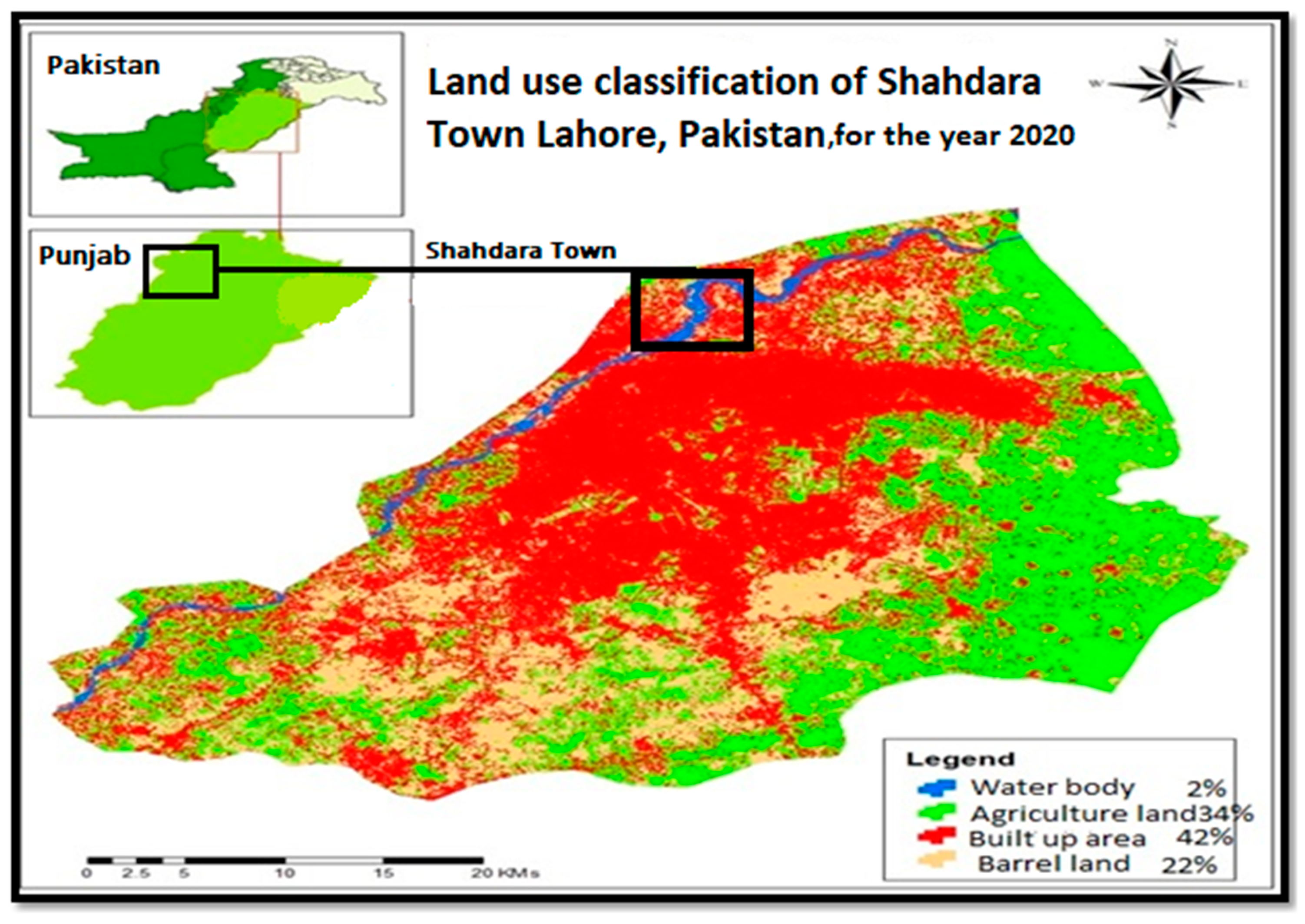
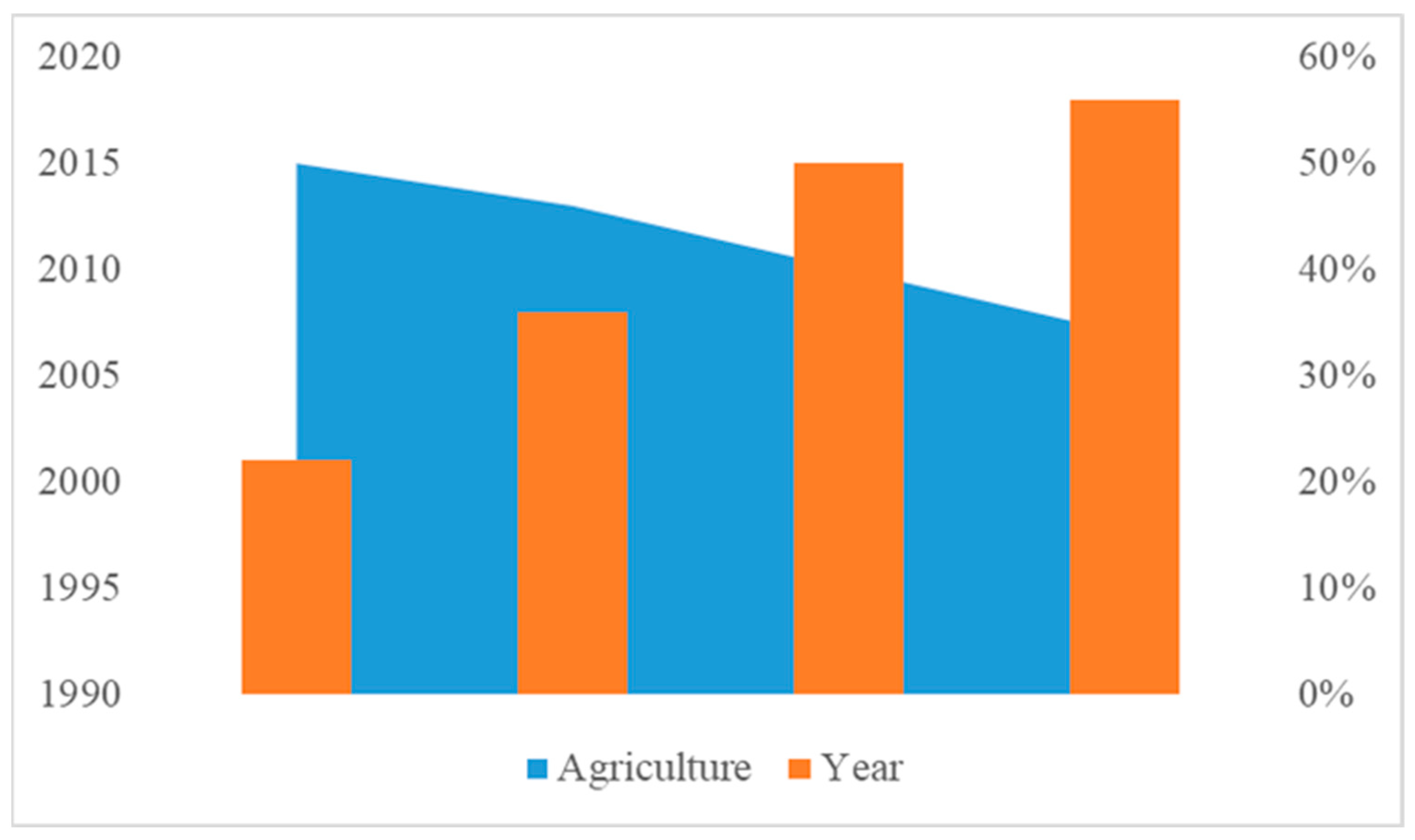
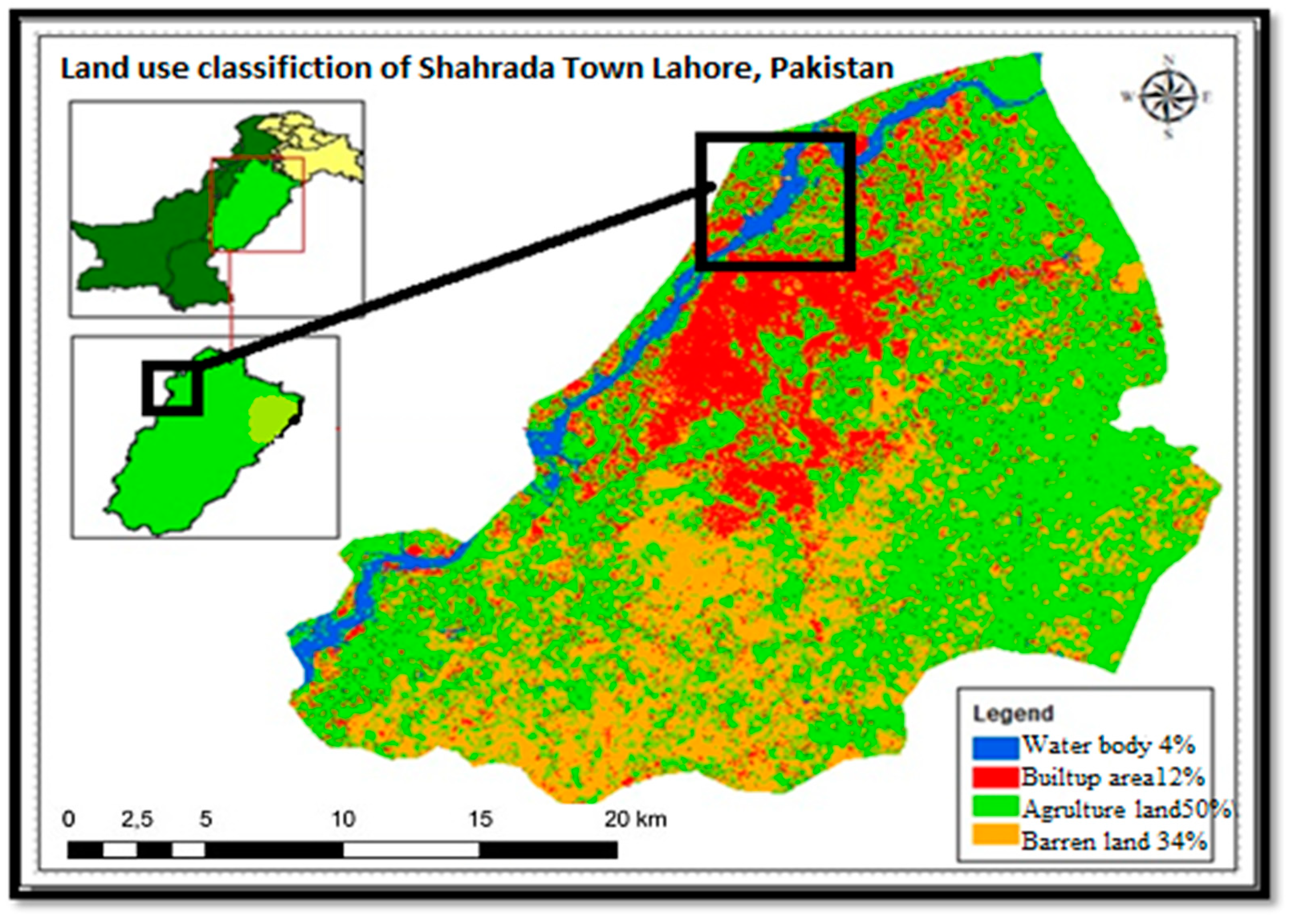
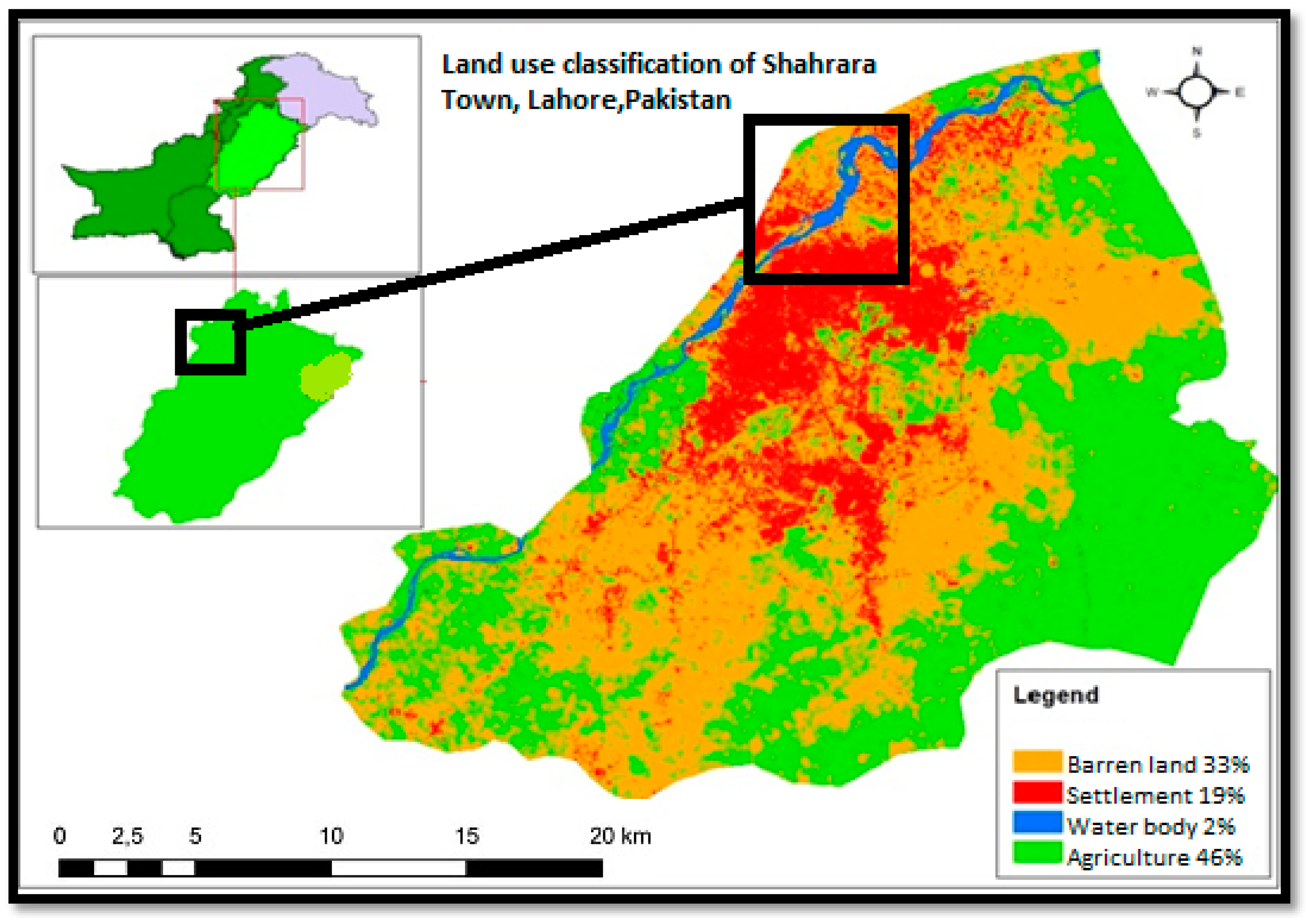
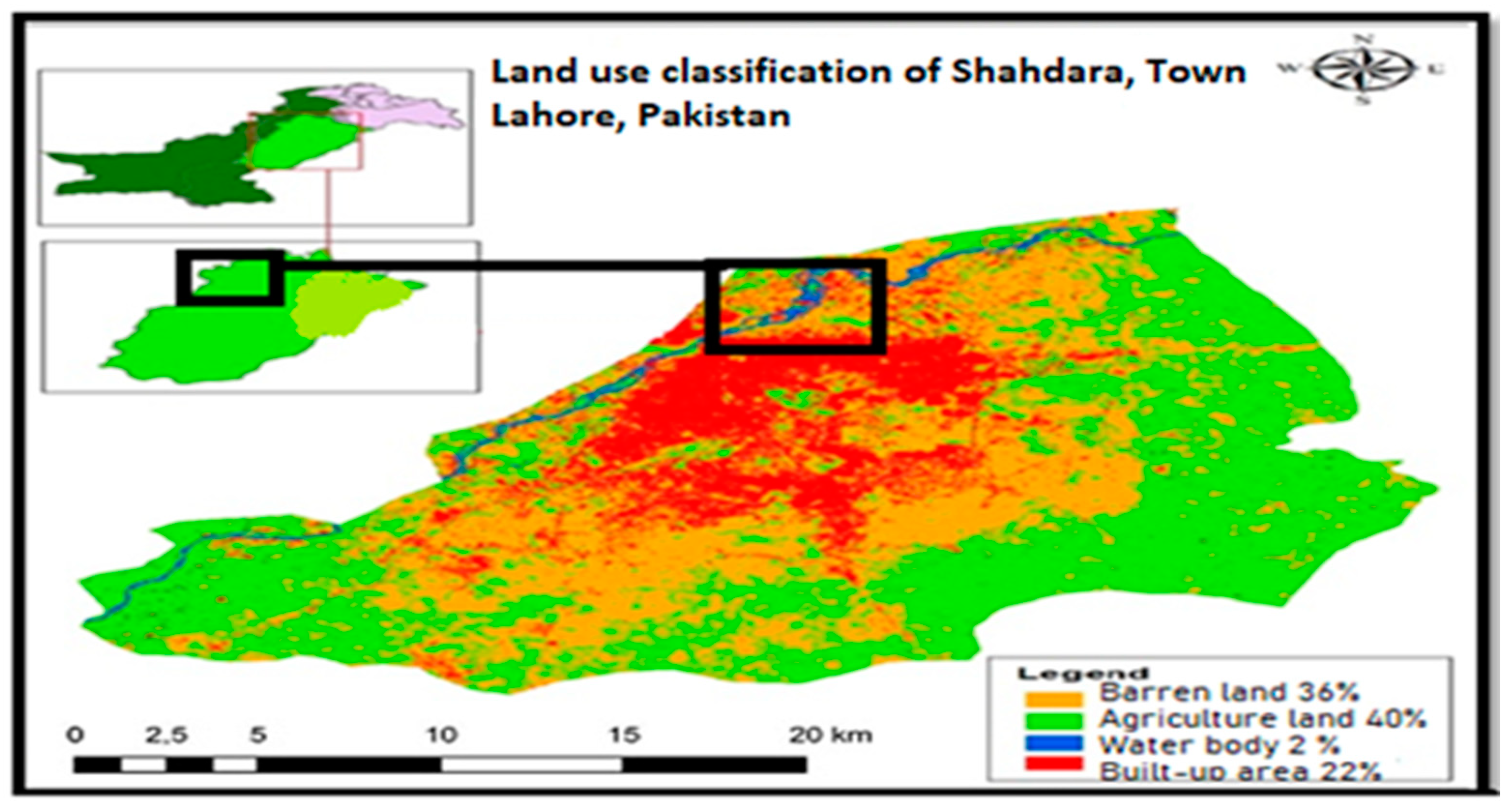
| Agriculture Products in Study Area | Production Ratio in Percentage | Consumption Ratio in Percentage | Selling Ratio | Total (Production, Consumption, and Selling) |
|---|---|---|---|---|
| Eggs | 36.3 | 24.2 | 6.8 | 69% |
| Vegetables | 26.2 | 15.4 | 5.6 | 79% |
| Meat and poultry | 7.8 | 17.3 | 15.5 | 68% |
| Fruits | 6 | 100 | 0 | 0% |
| Types of Farming | Percentage (%) |
|---|---|
| Kitchen garden | 47% |
| Fruit production | 6% |
| Domestic livestock (milk, eggs, etc.) | 40% |
| Flowers production | 5% |
| Model | R | R Square | Adjusted R Square | Std. Error of the Estimate |
|---|---|---|---|---|
| 1 | 0.857 | 0.728 | 0.725 | 1.060 |
| Regression Coefficient | Minimum | Maximum | Mean | Std. Deviation | N |
|---|---|---|---|---|---|
| Predicted Value | 2.66 | 4.84 | 3.68 | 0.405 | 950 |
| Residual | 2.799 | 1.817 | 2.876 | 1.058 | 950 |
| Std. Predicted Value | 2.509 | 2.882 | 0.000 | 1.000 | 950 |
| Std. Residual | 2.642 | 1.714 | 0.000 | 0.998 | 950 |
| Regression Coefficient | Minimum | Maximum | Mean | Std. Deviation | N |
|---|---|---|---|---|---|
| Predicted Value | 2.66 | 4.84 | 3.68 | 0.405 | 950 |
| Residual | 2.799 | 1.817 | 2.876 | 1.058 | 950 |
| Std. Predicted Value | 2.509 | 2.882 | 0.000 | 1.000 | 950 |
| Std. Residual | 2.642 | 1.714 | 0.000 | 0.998 | 950 |
| Years | Agricultural Land | Barren Land | Built-up Area | Water |
|---|---|---|---|---|
| 2001 | 50% | 34% | 12% | 4% |
| 2008 | 46% | 33% | 19% | 2% |
| 2015 | 40% | 36% | 22% | 2% |
| 2020 | 34% | 22% | 42% | 2% |
Disclaimer/Publisher’s Note: The statements, opinions and data contained in all publications are solely those of the individual author(s) and contributor(s) and not of MDPI and/or the editor(s). MDPI and/or the editor(s) disclaim responsibility for any injury to people or property resulting from any ideas, methods, instructions or products referred to in the content. |
© 2023 by the authors. Licensee MDPI, Basel, Switzerland. This article is an open access article distributed under the terms and conditions of the Creative Commons Attribution (CC BY) license (https://creativecommons.org/licenses/by/4.0/).
Share and Cite
Anwar, M.M.; Breuste, J.H.; Ahmad, A.; Aziz, A.; Aldosari, A.A. Quantifying the Impacts of Urbanization on Urban Agriculture and Food Security in the Megacity Lahore, Pakistan. Sustainability 2023, 15, 12143. https://doi.org/10.3390/su151612143
Anwar MM, Breuste JH, Ahmad A, Aziz A, Aldosari AA. Quantifying the Impacts of Urbanization on Urban Agriculture and Food Security in the Megacity Lahore, Pakistan. Sustainability. 2023; 15(16):12143. https://doi.org/10.3390/su151612143
Chicago/Turabian StyleAnwar, Muhammad Mushahid, Juergen H. Breuste, Ayaz Ahmad, Asad Aziz, and Ali Abdullah Aldosari. 2023. "Quantifying the Impacts of Urbanization on Urban Agriculture and Food Security in the Megacity Lahore, Pakistan" Sustainability 15, no. 16: 12143. https://doi.org/10.3390/su151612143
APA StyleAnwar, M. M., Breuste, J. H., Ahmad, A., Aziz, A., & Aldosari, A. A. (2023). Quantifying the Impacts of Urbanization on Urban Agriculture and Food Security in the Megacity Lahore, Pakistan. Sustainability, 15(16), 12143. https://doi.org/10.3390/su151612143










